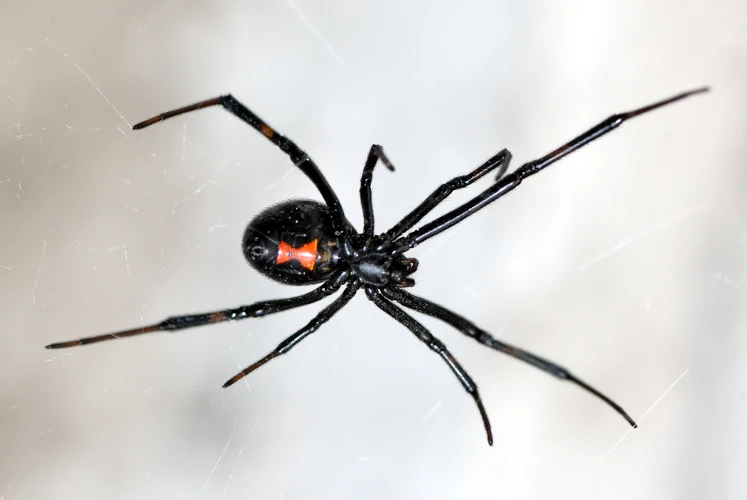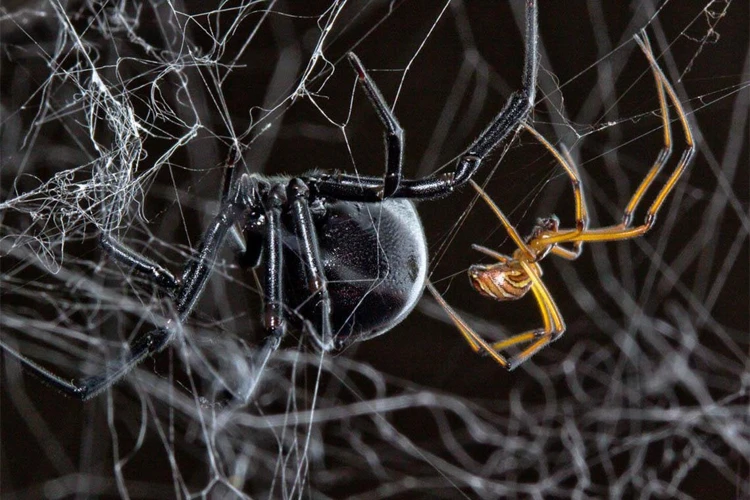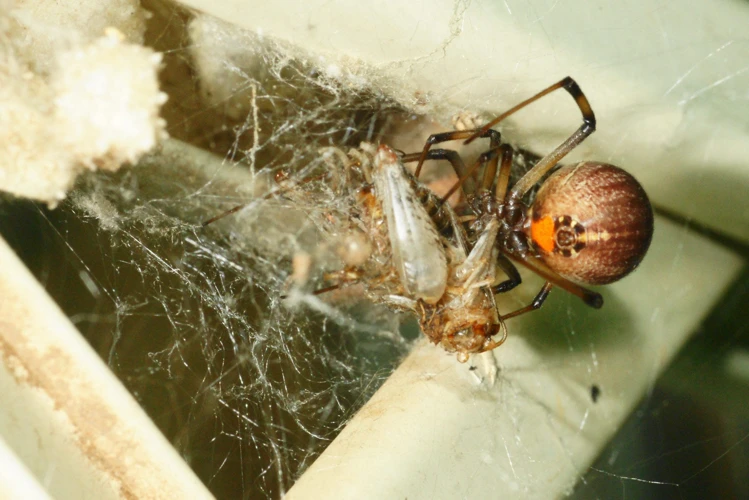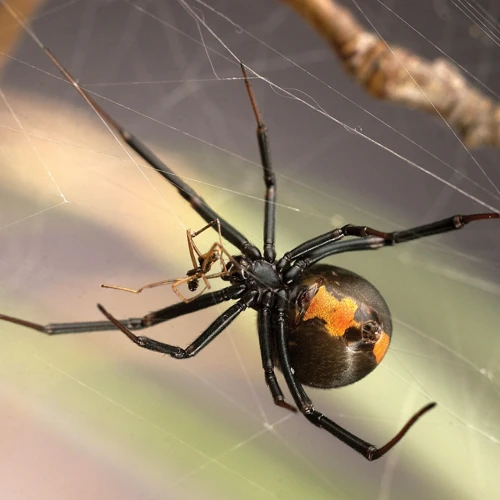There is something captivating yet frightening about the Black Widow spider. These eight-legged creatures, known for their venomous bite and the infamous red hourglass on their abdomen, have a mysterious and intriguing mating behavior. How do these spiders reproduce? Why do females eventually eat their mates? And what can scientists teach us about this deadly dance? In this article, we will delve into the mating rituals of Black Widow Spiders and explore everything you need to know about their courtship, co-habitation, and cannibalism after mating. Get ready to be both captivated and terrified by this fascinating world of spider mating behavior!
Why do Black Widow Spiders Eat Their Mates?

As one of the most notorious aspects of Black Widow spider behavior, the topic of why they eat their mates has puzzled and intrigued scientists for years. The phenomenon of sexual cannibalism in spiders is not uncommon, but the Black Widow’s behavior is particularly enigmatic. What could possibly drive the female to kill and consume her mate, even as he is in the act of fertilizing her? In this section, we will dive into the various theories behind this behavior, from female predation to male sacrifice. Stay tuned to find out more about this unique aspect of Black Widow mating behavior.
Female Predation: A Deadly Game
Black widow female spiders have been notorious for killing their male partners during or immediately after mating. While this may seem cruel and unusual, it is actually a common strategy in the animal kingdom.
Female black widows are larger and stronger than males, and they are naturally aggressive towards their partners. Their tendency to attack and even devour their mates can be attributed to two main reasons: hunger and reproductive success.
The female black widow spider consumes her mate for the sake of nutrition, as mating can take up a lot of her energy reserves. This makes it crucial for her to kill and consume her partner to ensure that she can produce viable eggs. Additionally, this act increases the likelihood of successful fertilization.
In terms of reproduction, black widow females are also focused on producing healthy offspring. They are able to discern the quality of potential mates through specific cues, such as body size and pheromones. By devouring their mates, they ensure that they have a greater chance of passing on their genes to the next generation.
It is important to note that not all female black widow spiders practice mate cannibalism. Some species exhibit a lower level of aggression towards their mates, indicating that there may be other factors at play. However, it is a common behavior among many black widow populations.
To prevent inbreeding, female black widows rarely mate with siblings or close relatives. This increases genetic diversity and reduces the chance of deformities in the offspring. The female’s aggression towards her mate is a calculated risk that has helped black widow spiders thrive in their environment.
If you want to learn more about black widow mating behavior, check out our articles on black widow mating strategies and male black widow spider mating.
Male Sacrifice: The Price of Mating
Male black widow spiders face a difficult and potentially deadly challenge when it comes to mating. As we discussed earlier, the female black widow spider is significantly larger and more dominant, so males need to be able to impress and seduce these females while avoiding being seen as a potential threat. However, even once a male has successfully mated with a female, he faces another danger – his partner might kill and eat him.
This behavior is known as sexual cannibalism, and it is a well-documented phenomenon among black widow spiders. In fact, research has shown that in some populations, more than 75% of males are killed by their mates. It may seem like a high price to pay for the opportunity to mate, but there are a few reasons why male black widows are willing to take the risk.
Firstly, as we noted earlier, male black widows have developed a few different strategies to try and avoid being cannibalized. These include things like choosing older or more satiated females, as well as being cautious and trying to avoid arousing suspicion. Additionally, once a male has successfully mated, his genes will have been passed on to the next generation – even if he doesn’t survive to witness his offspring.
Finally, there is some evidence to suggest that sexual cannibalism may actually benefit the males in some cases. For example, studies have shown that males who are killed and consumed by their mates tend to have higher reproductive success – their offspring are more likely to survive and thrive than those of males who escaped unscathed. This is because the nutrients from the male’s body can help to support the development of the female’s eggs, leading to healthier and stronger offspring.
Of course, this doesn’t mean that all male black widow spiders are actively seeking out sexual cannibalism – far from it. However, it does indicate that this seemingly grisly behavior may be more complicated than it first appears. Nevertheless, the risk of being killed after mating highlights the extreme nature of sexual selection in black widow spiders and the evolutionary pressure on males to find a way to balance mating opportunities with survival prospects.
If you want to learn more about the biology and behavior of black widow spiders, check out our other articles on topics like the anatomy of their reproductive systems, male mating strategies, the frequency of mating, and more.
The Courtship Dance of Black Widow Spiders

The courtship dance of black widow spiders is an intricate and fascinating process that plays a crucial role in the success of mating. The courtship ritual typically begins with the male black widow approaching the female’s web, which is often marked with pheromones to signal her readiness to mate.
Once the male approaches, he will begin to vibrate his body and extend his legs in a specific pattern to communicate his intentions. He will then approach the female and attempt to touch her abdomen with his pedipalp, a specialized structure located on the front of his body that is used for mating.
However, the female doesn’t always welcome the male’s advances with open arms – or legs, in this case. In fact, female black widows are known for being particularly aggressive towards potential mates. To avoid becoming a meal instead of a mate, the male must be quick on his feet and dodge the female’s lethal bite.
If the male is successful in making contact with the female’s abdomen, he will then begin the process of transferring his sperm to her. This can take anywhere from a few minutes up to several hours, and may involve multiple copulations. The male’s goal is to ensure that his genes are passed on to the next generation, while the female is often looking for the best possible mate to ensure high-quality offspring.
Interestingly, male black widows have been observed engaging in what is known as “sperm competition”. This involves physically removing sperm from previous males that have mated with the female, and replacing it with their own. This strategy can increase their chances of fathering offspring.
The courtship dance of black widow spiders is a complex and often dangerous process. However, it is an essential step in ensuring the survival and genetic diversity of the species. To learn more about the fascinating world of black widow mating rituals, check out our article on black widow spider mating.
Life After Mating: Co-habitation and Cannibalism

After the intense act of mating, a Black Widow Spider’s life takes an even more perilous turn. Some males survive the mating process, only to be killed and consumed soon after by their mate. This act of cannibalism occurs quite often, as male spiders can be up to four times smaller than the female, which makes them an easy target.
However, there are also cases where the male spider does not become a meal and instead cohabitates with the female for the remainder of his short lifespan. Studies have shown that when a male spider provides the female with a nuptial gift, he is more likely to avoid being cannibalized as the gift provides an energy source for the female to produce offspring.
Interestingly, male Black Widow Spiders have been known to mate with multiple females. However, these males do not necessarily live longer than those who mate only once. In fact, this behavior may even shorten their lifespan, as they have to compete more fiercely for mating opportunities. It is not entirely understood why males risk their lives for multiple mating opportunities in a species where survival is already difficult.
Long-term cohabitation between males and females can result in inbreeding, which is detrimental to the fitness and survival of offspring. To prevent inbreeding, Black Widow Spiders have developed mechanisms to recognize kin in their local area and avoid mating with them. This may include kin recognition through the vibrations and odors emitted by other spiders or their webs.
Life after mating for Black Widow Spiders is a perilous journey that often ends in cannibalism for the male. However, under certain circumstances, some males manage to cohabitate with the female for a short period. Mating is a highly competitive and risky behavior among male Black Widow Spiders, which makes understanding their mating strategies all the more interesting for scientists. To learn more about Black Widow Spider mating behaviors, read more about preventing inbreeding, mating duration, and mating frequency.
How Do Scientists Study the Mating Behavior of Black Widow Spiders?
To fully understand the mating behavior of Black Widow spiders, scientists have had to employ a variety of techniques and technologies. One of the most common methods for studying mating behavior is direct observation of spiders in their natural habitat. By observing the spiders, researchers can learn about their courtship behavior, the act of mating, and the aftermath of the mating process.
Another method scientists use is controlled laboratory experiments. In these experiments, researchers manipulate certain variables and observe how they affect the spiders’ behavior. For example, scientists may alter the amount of light or temperature in a spider’s environment to see how it affects their mating behavior.
One interesting experiment that scientists have conducted involves presenting male Black Widow spiders with potential mates. Researchers have found that males are more likely to mate with larger females, as they produce more offspring.
Other scientists have focused on the chemical signaling behavior of Black Widow spiders. Female Black Widows produce a pheromone that attracts males, and scientists have studied how males respond to this pheromone in the wild.
Some researchers have made use of molecular biology techniques to better understand the genetics of Black Widow mating behavior, such as studying the DNA of different males to see what factors may contribute to their success in mating.
Studying the mating behavior of Black Widow spiders is crucial to understanding the biology of this unique species. By using a range of techniques, scientists are slowly revealing the secrets of these fascinating creatures. If you want to learn more about the male Black Widow spider’s role in the mating process, you can read our article about male Black Widow spider mating. Another topic you may find interesting is male Black Widow mating competition.
Conclusion
In conclusion, the mating rituals of black widow spiders are both fascinating and complex. From the deadly game of female predation to the sacrificial behavior of male spiders, these creatures have developed intricate ways to reproduce.
Despite the potential cannibalistic aftermath of mating, male black widow spiders will still go through with the courtship dance to ensure their genes are passed on to the next generation.
The co-habitation period after mating also plays a crucial role in the survival of the offspring, as the female spider will protect her eggs and her newfound mate from potential predators.
Scientists have been studying black widow spider mating behavior for years, using methods such as observation, experimentation, and molecular techniques to better understand these creatures.
Through these studies, they have discovered many new insights into the behavior and physiology of these fascinating creatures, and more research is sure to yield even greater understanding.
Overall, black widow spiders are some of the most intriguing and captivating creatures in the animal kingdom, with their unique mating rituals and complex behaviors. It is both thrilling and humbling to have the opportunity to study them and uncover the mysteries of their remarkable species.
Frequently Asked Questions
What is the mating behavior of black widow spiders?
The mating behavior of black widow spiders involves a courtship dance where the male approaches the female and performs certain movements to attract her attention and calm her aggression. After mating, the male will either leave or be killed and eaten by the female.
Why do female black widow spiders eat their mates?
Female black widow spiders eat their mates as a source of nutrients to support themselves during pregnancy and to prevent other males from mating with them. It is also believed that male sacrifice may improve the chances of successful insemination.
Do all female black widow spiders eat their mates?
No, not all female black widow spiders eat their mates. This behavior typically occurs in captive populations, where the female has limited access to food and is more likely to consume her mate for extra nutrients.
What is the role of male black widow spiders in mating?
The role of male black widow spiders in mating is to approach the female and perform a courtship dance to attract her attention and calm her aggression. After mating, the male may either leave or be killed and eaten by the female.
How do black widow spiders find mates?
Male black widow spiders typically approach females through pheromone detection. They follow the scent left behind by the female and perform a courtship dance to attract her attention and calm her aggression.
Do male black widow spiders try to avoid getting eaten by the female?
Yes, male black widow spiders try to avoid getting eaten by the female. They may use certain movements during the courtship dance to prevent the female from attacking them and may also attempt to mate from a safe distance.
What happens to the female black widow spider after mating?
After mating, the female black widow spider will lay her eggs and may either cohabitate with the male (if he is still alive) or kill and eat him. She will then guard her eggs until they hatch and the spiderlings emerge.
What happens if a male black widow spider is not accepted by the female?
If a male black widow spider is not accepted by the female or fails to mate successfully, he will typically leave and seek out another potential mate.
How do scientists study the mating behavior of black widow spiders?
Scientists may study the mating behavior of black widow spiders in laboratory settings by observing their interactions and recording data. They may also use techniques like DNA analysis to study paternity and identify genetic relationships between spiderlings and their parents.
Are black widow spiders dangerous to humans?
Yes, black widow spiders can be dangerous to humans. Their venom can cause symptoms like muscle cramps, nausea, and difficulty breathing. While fatalities are rare, medical attention should be sought immediately if bitten by a black widow spider.







